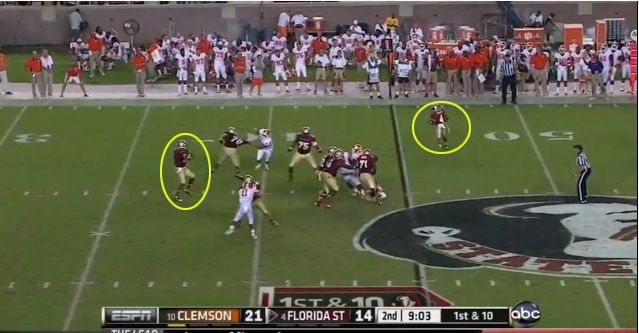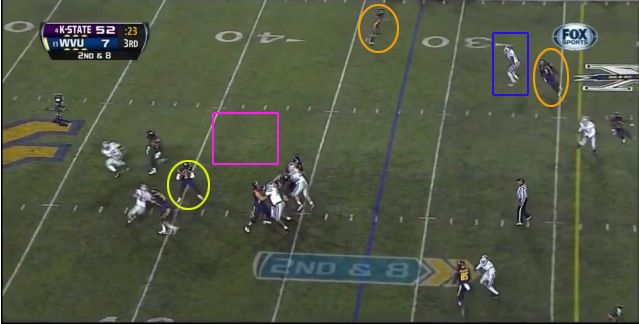In the NFL, a key trait of quarterbacks and their development into successful starters or even legends is their ability to take what the defense offers. The great quarterbacks have molded themselves on making the easy plays look easier and the harder plays look easy.
Tom Brady, Peyton Manning, Drew Brees, and Aaron Rodgers. These quarterbacks are considered the elite group in the NFL precisely because they limit their mistakes for the most part. Drew Brees, the most aggressive and vertical of this group, often has interception numbers that nearly double the others because he takes those chances and takes those risks.
Often times, quarterbacks who dump the ball off are decried as dinking and dunking down the field or are regarded as average to above average quarterbacks. Alex Smith, now on the Kansas City Chiefs, is a primary example of a quarterback who took the open man, cut down on his mistakes, and is merely regarded as a game managing quarterback even after his performance against Green Bay in the 2011 NFC playoffs.
What separates the great quarterbacks from the average quarterbacks is the self discipline and mental intelligence to recognize and take the underneath even if it is not as pretty as a 30 yard bomb down the sidelines. The phrase: To live another day would be most apt to what will be discussed except this will be, “To live another down.”
Our first example is a quarterback that has steadily risen up teams draft boards in the months of March and April. E.J. Manuel of Florida State. Against Clemson, he displayed the ability to not only run different types of plays (including Shotgun snaps, Rollouts, and Option runs) but more importantly showed the maturity to not put his offense at risk by playing mistake free football.
Jumping to 2:58 in the video. It is 1st & 10 at the Florida State 45 yard line with 9:09 left in the 2nd Quarter. Florida State is down just a touchdown in what has been a see-saw affair at this point. Clemson shows blitz with a 3 Man Front. Clemson ends up sending a Zone Blitz with the WLB dropping into coverage and the SLB blitzing.

At the top of his drop, after faking a handoff to the RB, E.J. finds himself with a wide open pocket in which to work with. You can also see that the nearest Clemson defender is at the Clemson 48 yard line.

E.J. climbs up in the pocket with a hitch step and immediately sees the RB angling towards the sideline after not getting what he wanted deep down the field. In the view that the TV Broadcast gives us, there is not a Clemson defender within 7 yards of the RB. It isn’t a fancy decision but it is the smart, safe play to make instead of forcing it downfield and risking a turnover.
The pass is completed to the RB but is a little high and towards the sideline. The RB snares the ball and stops himself at the sideline from running out of bounds. He squares his body upfield before getting met quickly by two closing Clemson defenders. The result of the play is a simple 2 yard gain but it continues the drive and allows for the offense two downs to not only shorten the field but also to get an easier first down.
Sure enough, what immediately follows is a first down completion on 3rd & 5 that takes the ball down to the Clemson 45 yard line. Florida State ended up punting after a sack and scramble on 3rd & 15 but E.J. Manuel displayed the discipline and maturity to recognize a chance to set up an easy third down situation while keeping the drive extended by opting for the safer, low risk play.
Later in the game (5:46 mark), Florida State is down 31-28 with 4:41 left in the 3rd quarter. E.J. and Florida State are facing a 2nd & 12 situation on their own 34 yard line. Clemson lines up with a 3 Man Over Front (shifting the DL towards the TE side). The LB shows blitz but drops into coverage, signaling Zone Coverage to Manuel.
At the top of his drop, E.J. immediately recognizes the LB taking the RB in the flat, leaving the WR running behind him wide open settling down into the open zone. E.J. completes the pass, leaving the WR 7 yards short of where the first down marker is. What is key is that E.J. makes his decision and completes the pass quick enough that it allows the WR to turn his body upfield towards the sideline and gain an additional 3 yards to set up a short, much more manageable 3rd & 3 situation to convert.
Once again, E.J. Manuel displays the discipline to take the short completion knowing it will set up a more manageable 3rd down situation while keeping the drive alive and keeping the Clemson defense on the field with the clock running. Manuel completes a pass to convert the third down and as a result of taking the quick throw on 2nd & 12 as opposed to forcing a downfield pass, the Florida State offense is able to find itself with a fresh set of downs and the ball at the Clemson 48. Sometimes taking less results in quarterbacks being able to do more.
A quarterback who has seen his stock rise and dip recently is Geno Smith of West Virginia. Against Kansas State, he put up a stat line of 21/32 for 143 yards with 1 TD and 2 INT. While it was an abysmal performance and he struggled greatly comparable to other games, we will dissect his performance in greater detail. In particular we will look at his decision making in regards to opting for downfield throws over the shorter, safer options.
Kansas State did a good job on defense but Geno struggled to take advantage of situations throughout the game, a mark of a quarterback that will struggle more often than not in the NFL if he does not correct it. Starting at 0:34 in the video, Kansas State lines up in a a Nickel Defense with two deep safeties. West Virginia has countered with a 5 Wide, Trips Right, on 3rd & 6 at their own 31 yard line. Kansas State is already up 10-0.

At the snap, Kansas State’s linebackers drop and show man coverage. The top of his drop should indicate to Geno that he has a man underneath immediately, matched up against a linebacker on a simple drag route. Most quarterbacks will make this throw as soon as the drop has finished. Further making the case for a quick throw is that both defensive ends are applying pressure quickly, which Geno should have no problem with if he has gotten the ball out already. The issue is that he keeps his eyes downfield and holds the ball.
The farthest LB is occupied with his man and the crossing WR seems to have a step on the LB covering him. Worst case scenario is that the LB gets an angle and takes the WR down. The more likely scenario is that the WR is able to turn upfield and either make the first down or make the LB miss and possibly get a bigger play as a result.
End result of the play is that Geno gets the ball stripped by the left DE, recovers the fumble, and scrambles for a loss of 3 yards.
Take the 5:01 mark in the video. Later in the game is an example of Geno’s inability to be patient and climb the pocket while keeping the play extended. The situation is 2nd & 8 on the Kansas State 32 with 27 seconds left in the 3rd quarter. Kansas State rushes just 4 and drops 7 to cover down the field. Geno keeps his eyes on the right side of the field and locks them on that area.

Geno shifts his attention towards the middle of the field and should be hitching up into the pocket to get a shorter throw and be able to scan the left side of the field as well. He does neither of these, however. You will also see the far side WR at the sideline start going vertical and the WR in front of the first down marker eventually settling into the open zone. What this does is freeze the CB and force him to make a decision, meaning that Geno would not only have 2 options on this play but by hitching up into the pocket, it’d also force the defender to concede the possibility that Geno could scramble for the first down as well.
The result is that Geno scrambles towards the right for a gain of just 3 yards while absorbing a shot from a defender as well.
In contrast to E.J. Manuel, Geno either kept his eyes downfield and opted for the vertical, more aggressive throw or struggled with his pocket presence and the ability to hitch up to give himself time to find an open man down the field.
The biggest struggle in the NFL is for the quarterbacks to learn to take the little things when they open themselves up. E.J. Manuel has already shown traits of this in college, which has helped impact the rise of his draft stock. Geno Smith, on the other hand, has to prove to teams that he can also translate the mental skills necessary to adapt to the fact that sometimes the best decision to make requires the easiest throw to make as well.
Credit to Ron Almog for the football image



One Comment
Leave a Reply